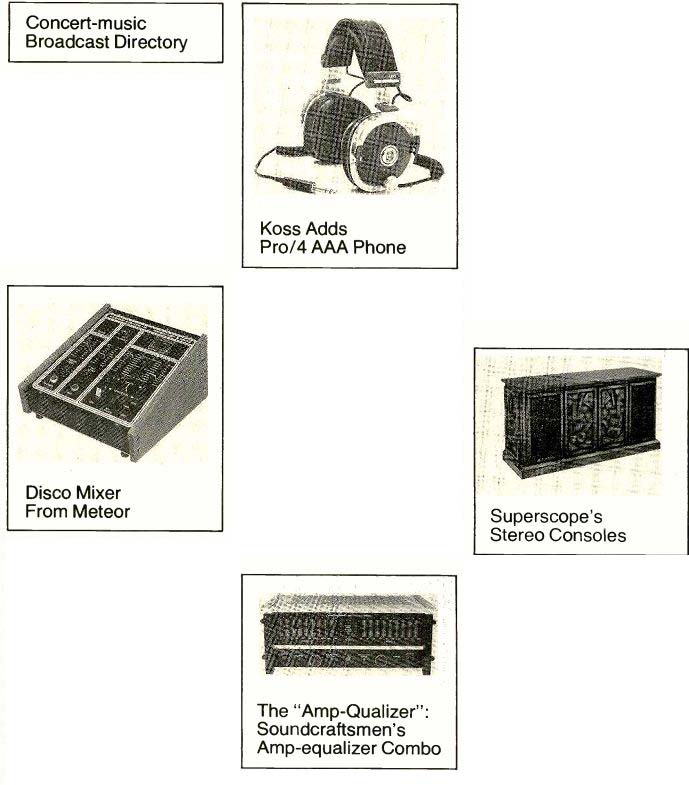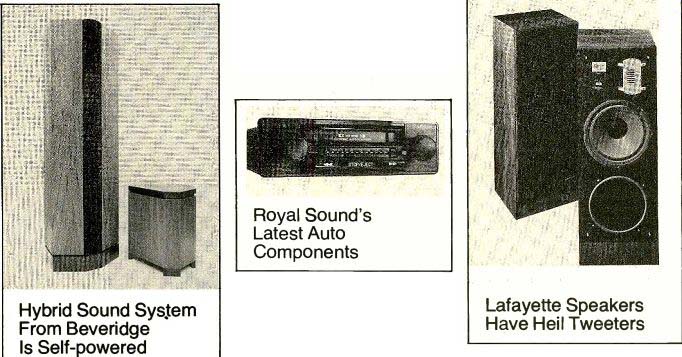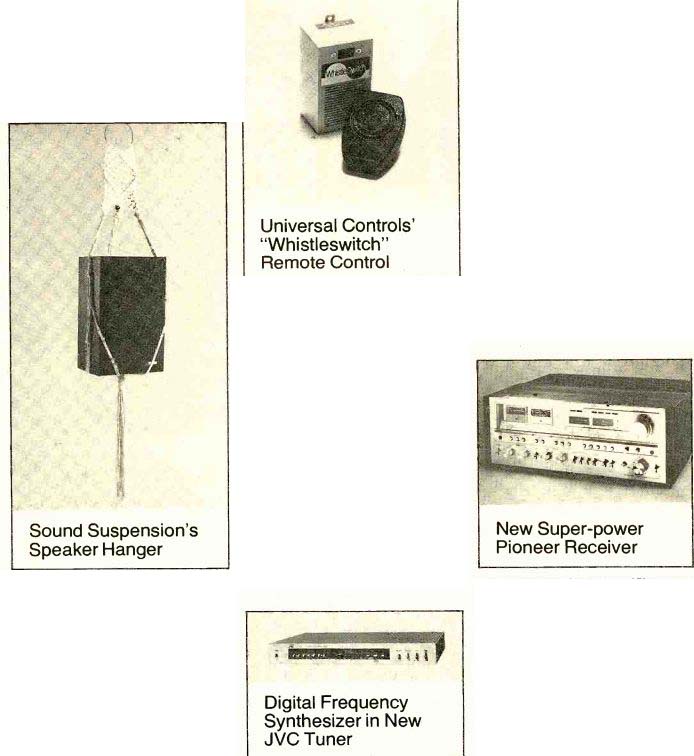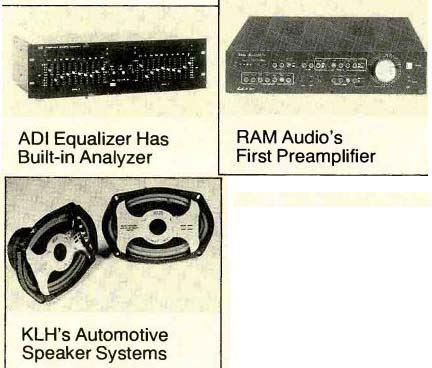Concert-music Broadcast Directory D Radio station WCLV-FM of Cleveland, Ohio (95.5 MHz) has announced the availability of its 1977-1978 national directory of concert-music broadcasts. The directory lists radio stations in the U.S. and Canada, both commercial and non-commercial, that broad cast concert music. Information listed for each station includes its frequency, transmitter power, antenna height, and personnel, as well as the weekly hours of concert-music broadcast and the program syndications received by the station. Price of the directory is $5 for one copy, $4 for each additional copy.
Order from WCLV, Penthouse East, Terminal Tower, Cleveland, Ohio 44113.
D Meteor Light and Sound's Clubman One-One-m is a two-in/one-out disco mixer that will accept two stereo inputs (either phono or line) and mix them into a single stereo output.
There are sliding level controls for the two stereo inputs as well as cueing switches for each. The cueing switches permit the user to monitor one input through a headphone while the other input is playing through the system's loudspeakers. There is a "crossfade" slider for fading from one stereo input to the other.

The mixer has a switchable low-frequency (50 Hz) filter. A microphone-mixer circuit with a defeat switch and level control permits the user to talk over the music program. The microphone input is a phone jack for high-impedance, unbalanced-line microphones.
The Clubman One-One-m has a mono headphone amplifier and a front-panel headphone volume control (this is meant for a single-ear disc-jockey headphone). There are also average-reading output-level meters for each stereo channel. Approximate dimensions are 101/2 inches wide and 11 1/2 inches deep; height tapers from 7 to 2 inches. Price: $249.
The Pro/4 AAA headphone is the latest addition to the Koss stereophone line. It is an isolating-type headphone with Pneumalite ear-cushions designed to fit the ear comfort ably. It also has a Pneumalite head cushion mounted under the free-floating, adjustable headband, and the band has newly designed bearings to facilitate sliding adjustments.
Each driver has a 1-inch voice coil and 2S square inches of radiating area.
The frequency range of the Pro/4 AAA is given as 10 to 22,000 Hz, and the nominal impedance is 220 ohms. An input of 0.24 volt wide-band pink noise results in a 100-dB SPL output. Total harmonic distortion at 1,000 Hz and 100-dB SPL is rated at less than 0.5 per cent. The headphone has a microphone boom mount on the left cup for professional applications. The Pro/4 AAA is provided with a coiled 3-meter (about 10 feet) cord, and it weighs about 15.5 ounces. Price: $75.
The "Amp-Qualizer": Soundcraftsmen's Amp-equalizer Combo
Soundcraftsmen's EA5003 Amp-Qualizer is a combination power-amplifier/equalizer that incorporates the innards of their MA5002 "Class H" power amplifier and 20-12 equalizer. The EA5003's equalizer section has ten band-pass filters centered at one-octave intervals from 30 to 15,360 Hz. In the center of the front panel there are slide controls for adjusting the overall level of the equalized signal; in their lowest position these controls defeat the equalizer completely. The power-amplifier section has level controls for each channel as well as switching for two pairs of speakers.
There are separate LED's for each channel that indicate clipping and the activation of Soundcraftsmen's "Vari-portional" power-supply-control system, a feature of the Class H circuitry.
The Amp-Qualizer is rated at 250 watts per channel continuous power into 8 ohms. The amplifier's total harmonic distortion is rated at under 0.1 per cent, and intermodulation distortion is under 0.05 per cent. The input required for full power output is 1.28 volts. The EA5003's noise level is better than-105 dB, and the slew rate is 50 volts per microsecond.
The EA5003, with dimensions of 7 x 19 x 15 inches, has walnut-grain side panels and grab handles. The side panels can be removed, making the unit suitable for 19-inch rack mounting. Weight is 55 pounds. Price: $849.
Superscope, Inc. recently formed a new Imperial Division to market stereo consoles and compact systems as well as other electronic items. Their new product line includes six stereo consoles, each of which includes an AM/FM stereo receiver and eight-track cartridge facilities as well as a three-speed record changer and two speaker systems. Four of the consoles have full cartridge recorders while two have just playback decks; in other respects the consoles are electronically identical: they differ physically in cabinet styles, sizes, and speaker systems. The receiver sections are rated at 5 watts per channel continuous power and have bass, treble, and balance controls as well as switchable AFC. The light ed tuning dial has a LED indicator for stereo broadcasts. There are jacks for headphones and auxiliary inputs. The consoles utilize a standard BSR record changer with a ceramic phono cartridge. The eight-track recorders (when supplied) have automatic recording-level adjustments, fast-forward and pause functions, and two microphone input jacks, as well as record and tape-stop LED's.
The Imperial consoles come in two basic sizes, the 44-inch and 55-inch models. The 44-inch consoles have two-way speaker systems with mechanical crossovers, utilizing 8-inch drivers in sealed enclosures. The 55-inch units have two-way sealed-enclosure systems with 8-inch woofers and 2 1/2-inch cone tweeters crossed over with a standard passive net work. The console cabinetry comes in three basic styles with two models in each style: Mediterranean, Colonial, and Contemporary.
Cabinets are constructed of particle board with wood-veneer finishes. The typical dimensions of a 44-inch console are about 26 x 43 1/2 x 17 inches; of a 55-inch console, 28 x 54 1/2 x 18 inches. Weights are about 110 and 125 pounds for the 44- and 55-inch units, respectively. Prices range from about $270 for the model D-700 to about $370 for the D-804.

Hybrid Sound System From Beveridge Is Self–powered
The Model 2SW, a self-powered hybrid loudspeaker system from Harold Beveridge, Inc., includes two electrostatic and two subwoofer speaker modules. Each electrostatic speaker, designed to cover the frequency range of 70 to 15,000 Hz, has a single driver mounted in a columnar enclosure that absorbs its back radiation. A long, narrow, vertical slit in front of the electrostatic element serves as an acoustic lens to enhance lateral dispersion to 180 degrees. The bass modules, which handle the frequencies between 30 and 70 Hz, contain 12-inch woofers in acoustic-suspension enclosures. Vacuum-tube mono power amplifiers mounted in the base of each electrostatic unit drive both the electrostatics and the subwoofers. Each amplifier unit also contains a conventional passive 70-Hz crossover and can be driven by the output of a regular stereo preamplifier. The 2SW system includes a control module, to be installed between the preamplifier and the speakers, which has controls for frequency balance, bass level, and channel separation. The frequency-balance control, called a "spectrum slope control," adjusts the slope of the output-level-vs.-frequency curve of the system ±0.8 dB per Hz.
The "bass environmental control" for adjusting bass level has a range of +2,-4 dB at 40 Hz. The "lateral control" mixes the two channels together to varying degrees in order to adjust the spread of the stereo image.
Maximum sound-pressure level is 110 dB in a 20 x 30-foot room, measured at a distance of 15 feet from the speakers. Rated frequency response of the 2SW is 30 to 15,000 Hz. The electrostatic units have dimensions of 6 1/2 x 2 x 1 1/2 feet, and the subwoofers measure 26 x 16 1/2 x 22 inches. Dimensions of the control module are 1 1/2 x 11 x 6 inches. Price of the entire 2SW system: $5,200. Beveridge plans to market both the subwoofer and the control module separately. Prices will be about $600 for the subwoofer and $300 for the module.
Royal Sound's Latest Auto Components
You can now get a graphic equalizer for your car-stereo system: Royal Sound's new EA-400 is a combination graphic equalizer/ power amplifier which provides up to 12 dB of boost or attenuation of five separate bands centered at 60, 250, 1,000, 3,500, and 15,000 Hz. The power-amplifier section of the EA-400 is rated at 20 watts per channel into 8 ohms. Total harmonic distortion at rated power is 2.6 percent and is lower at reduced powers. Dimensions are 2 x 6 1/2 x 6 1/2 inches. Price: $180.
The Model RS-3110 (shown) is an in-dash AM/FM stereo radio and cassette player. It features an automatic electronic tuning sys tem that scans for and tunes in stations strong enough to be received. In addition, five preset stations ( two AM and three FM) can be selected with the optional PSA-5 remote-control preset adapter. Other radio features include LED's to indicate stereo broadcasts and to illuminate the dial and indicator lights for mode (AM or FM). The cassette player features automatic reverse and locking fast-forward/ rewind switches. The tuner's usable FM sensitivity is 2 microvolts (17.3 dBf with a 75-ohm antenna input). Stereo separation is 25 dB. The cassette player has under 0.45 per cent wow and flutter (wrms) and a frequency response of 40 to 12,500 Hz. The RS-3110 is rated at 7 watts per channel into 8 ohms and can be used with either 4- or 8-ohm speakers.
Approximate dimensions of the unit are 2 x 7 x 6 1/2 inches; the PSA-5 selector measures about 13/4 x 4 x 21/2 inches. Prices: $550 for the RS-3110, $60 for the PSA-5.
The RS-3110 radio/cassette player is in tended for in-dash mounting (it has the standard sliding front-panel shafts for universal installation); the EA-400 and PSA-5 are meant for under-dash installation. All the units are designed for use with 12-volt negative-ground systems.
---------- Lafayette Speakers Have Heil Tweeters
Lafayette's Criterion 3000 line of loud speaker systems, including the Models 3001, 3002, and 3003 (shown), all utilize the Heil "Air-Motion Transformer" for the high-frequency driver. All are two-way vented-box systems; the 3002 and 3003 have passive radiators. The 3001 has a 10-inch woofer, the 3002 a 10-inch woofer and 10-inch passive radiator, and the 3003 a I2-inch woofer and 12-
inch passive radiator. The 3002 and 3003 are equipped with level controls for the tweeter.
The top-of-the-line 3003 (shown) has a rat ed frequency response of 30 to 25,000 Hz ±3 dB and a nominal impedance of 6 ohms. A 1-watt input produces a sound-pressure level of 91 dB at 1 meter. The crossover frequency is
(Continued on page 22)
New Products latest audio equipment and accessories
2,000 Hz. Minimum input is 20 watts per channel continuous power; maximum continuous input is 70 watts per channel. The 3003, which weighs about 60 pounds, has approximate dimensions of 39 x 14 1/4 x 13 1/2 inches. Price: about $300. The 3002 and 3001 are priced at about $240 and $200.
Sound Suspension's Speaker Hanger
Sound Suspension Ltd. is offering a new type of speaker support: the speaker hanger.
The macramé hangers have a "seat" that holds speakers up to 18 inches wide or deep and 30 inches high, with a weight capacity of up to 400 pounds. The speaker can be tilted forward through a considerable angle before the configuration becomes unstable. The hangers have a large brass ring for attachment to hooks or other fixtures in the ceiling. Be sides their decorative quality, the hanging speaker mounts minimize mechanical coupling of the loudspeaker enclosure and room surfaces, thus reducing the potential for acoustic feedback.
The Sound Suspension hangers come either in white cotton or natural jute (brown). Price: $45 per pair. Custom macramé designs are also available, starting at $5 extra per pair.
Order from: Sound Suspension Ltd., P.O. Box 386, Hermosa Beach, Calif. 90254.
Include $1.50 for postage and handling.
Universal Controls' "Whistleswitch" Remote Control
The Whistleswitch, from Universal Controls, is a remote-control switch for home-electronic appliances, including hi-fi systems.
The switch system consists of a soft-plastic, hand-held sonic transmitter and a receiver module that plugs into the a.c. outlet. The appliance to be switched is plugged into this module. The transmitter emits an ultrasonic tone when squeezed; this is received by the module, which then switches on the a.c. power. The range of the ultrasonic transmitter is said to be 50 feet; there is a sensitivity control on the receiver that permits the user to adjust for the minimum required range (this is necessary to prevent accidental triggering of the switch).
The Whistleswitch is capable of switching appliances that draw up to 400 watts of power. It accepts a two-prong, non-grounded plug from the appliance. Dimensions of the receiver are 4 1/4 x 2 1/2 x 2 inches; the handheld transmitter measures--- inches. Price: about $25.

Digital Frequency Synthesizer in New JVC Tuner
The JVC T-3030 is a low-profile FM tuner that utilizes a digital frequency synthesizer.
The tuner has a digital LED readout and push button controls for scanning the FM frequency range-one can scan both "up" and "down," and there is a "quick" button for speeding up the scan rate. Up to seven stations can be pre-tuned and inserted into the tuner's "memory" (there are seven pushbuttons on the front panel for this). The relative signal-strength indicator consists of five LED numbers, I through 5 (5 being "strong" and I "weak"). There are two FM-muting settings.
A hi-blend feature increases the signal-to noise ratio of weak signals. A record-level ca libration switch introduces a tone corresponding to a 50-per-cent-modulated FM signal.
The usable sensitivity of the T-3030 is claimed to be I FIN (11.2 dBf); 50-dB quieting sensitivity is 1.9 µV (16.8 dBf) in mono and 19 1.1.V (36.8 dBf) in stereo. Capture ratio is I dB and AM suppression is 65 dB. Alternate-channel selectivity is 80 dB. Stereo FM separation is 45 dB at 100 and 10,000 Hz and 50 dB at 1,000 Hz. Distortion is under 0.1 per cent, and the overall signal-to-noise ratio is 75 dB in mono and 72 dB in stereo. The T-3030 has both fixed and variable-level outputs; the fixed output is 750 millivolts into 2,500 ohms and the variable output is adjustable from 0 to 1.5 volts into 2,500 ohms. There is a 75-ohm coaxial antenna input. Dimensions are about 2 1/2 x 16 1/2 x 13 3/4 inches. Price: $600.
New Super-power Pioneer Receiver
Pioneer's SX-1980 bears a 270-watt-per channel rating. The large front panel has two peak-reading power meters calibrated from 0.01 to 540 watts. There is a "multipath" switch that allows the user to monitor the multipath distortion in the FM signal by ear.
There are two bass and two treble tone controls, each with a different turnover frequency: 50 and 100 Hz for the bass, 10,000 and 20,000 Hz for the treble. There is also a tone-
defeat switch, which cuts out the tone controls altogether. The SX-1980 provides for a variety of cartridge loads in its two phono in puts, including impedances of 10,000, 50,000, and 100,000 ohms and capacitances of 100, 200, 300, and 400 picofarads. There is a tuning-lock circuit that is defeated when the user touches the tuning knob; the circuit employs a phase-locked loop with a quartz-crystal reference oscillator. A LED labeled "fine tune" lights when the circuitry locks onto a station.
Maximum total harmonic distortion in the SX-1980's amplifier circuits is 0.03 per cent at the rated power output of 270 watts per channel into 8 ohms. Intermodulation distortion is 0.03 per cent. The phono signal-to-noise ratio (S/N) is 87 dB, and the phono inputs have a switchable radio-frequency-interference filter. Phono overload level is 300 millivolts.
The usable sensitivity of the SX-1980's FM tuner section is 1.5 microvolts (µN), or 8.7 dBf, and the 50-dB quieting sensitivity is 2.2 uV (11.5 dBf). Capture ratio is 1 dB and alternate-channel selectivity is 80 dB. The AM rejection is 60 dB, and image and spurious-response rejection are both 120 dB. Mono FM distortion is 0.1 per cent, and the ultimate tuner S/N is 83 dB (65-dBf input). The SX-1980 measures approximately 8 1/4 x 22 x 19 1/2 inches and weighs 78 pounds. Price: $1,250.
ADI Equalizer Has Built-in Analyzer
ADI's Model 1500 Graphic Equalizer features circuitry and indicators that tell you when you've achieved a flat acoustic frequency response with your system. The 1500 has a built-in pink-noise source and input jacks for a measuring microphone. It has a row of LED indicators, one red and one green for each band of each channel (there are ten bands per channel). To use the calibration feature, the user sets the 1,000-Hz level control to its center position; the LED's for the other bands will light up when the audio energy in any band differs from the 1,000-Hz level by more than ±0.75 dB. (The red LED lights up when the level of a particular band is above, and the green LED when it is below the 1,000-Hz level.) Both LED's light simultaneously when the level in the particular band is identical (within ±0.75 dB) to the 1,000-Hz level. The 1500 has pushbutton switches for each channel to put the equalizer into the "calibration" mode; there is a front-panel control for the level of the pink-noise source. In the equalizer mode, the 1500 is used much like other graphic equalizers.
The 1500 covers the ten ANSI-standard octaves with a range of ±-12 dB. Frequency response, with all controls set at zero (unity gain) is 20 to 26,000 Hz ±1.5 dB. Noise level is-104 dB relative to a 22-dBm maximum output at clipping (1 dBm is 1 milliwatt into 600 ohms) and-82 dB relative to 0 dBm. The input impedance is 10,000 ohms and output impedance is 250 ohms. Total harmonic distortion is under 0.05 per cent from 20 to 20,000 Hz at 0 dBm.
Regarding the calibration section of the 1500, the microphone amplifier sensitivity is adjustable from-70 to-20 dBm; line sensitivity is adjustable from-30 to +20 dBm.
The pink-noise generator puts out 20- to 20,000-Hz pink noise with equal energy per octave within +0,-1 dB. Approximate dimensions of the 1500 are 5 1/4 x 19 x 10 1/4 inches; the front panel is designed for rack-mounting. Price: $795.
ADI's optional calibration microphone (Model C-90) is $75.
KLH has entered the automotive-sound market with several new car speaker systems.
One of these is the 693DMSC, a three-way driver with a 6 x 9-inch oval woofer, a 1-inch dome mid-range, and a samarium-cobalt tweeter mounted to one side of the mid-range.
The speaker has a rated frequency response of 40 to 30,000 Hz and a nominal 8-ohm impedance. It is 41/4 inches deep and is de signed for rear-deck or in-door mounting.
KLH also has two new two-way systems, each with 6 x 9-inch oval woofers. The 692DT has a 1-inch dome tweeter and the 392CT a 1 1/4-inch cone tweeter. Both 8-ohm systems have frequency ranges of 40 to 20,000 Hz.
The 692DT and 692CT are each 4 1/4 inches deep and are meant for rear-deck or in-door mounting.
The KLH "Headliner" series of car speaker systems are true "component" systems for example, the Headliner V system includes two 6 x 9-inch oval woofers and two piezo electric high-frequency drivers. The high-frequency units are designed to be mounted in the front of the car at ear level; the woofers can be mounted in the usual fashion. Level controls are provided for the high-frequency drivers. The Headliner III consists of only the high-frequency drivers and is intended to be an add-on system for use with existing woofers. Prices of the KLH car speakers (all per pair) are about $215 for the 693DMSC, $145 for the 692DT, $120 for the 692CT, $170 for the Headliner V, and $120 for the Headliner III.
RAM Audio's First Preamplifier
RAM Audio Systems' Model 200 stereo preamplifier indicates the output level for each channel by a row of eight LED's labeled from-36 to +10 dBm. There are two phono inputs, each of which has alterable input impedance and capacitance. For the phono-1 input the impedance is adjustable from 6 to 47,000 ohms in 13-ohm steps and the capacitance from 5 to 1,855 picofarads (pF) in 50-pF steps; phono-2 impedance is adjustable from 1,000 to 78,000 ohms in 2,000-ohm steps and capacitance from 5 to 385 pF in 10-pF steps.
The preamplifier can accept the outputs of moving-coil cartridges directly.
In addition to phono, tape, tuner, and auxiliary inputs, the RAM 200 has a front-panel high-level input. Regular input jacks are located on a subpanel beneath the cover plate, and cables feed out through a rear-panel opening.
The volume control is a thirty-six-position step-type attenuator with gold-plated switch contacts and precision metal-film resistors.
There is a-20-dB muting switch that changes the gain of the output stage to unity. Another muting circuit automatically applies 73 dB of attenuation when the unit is turned on or off; it can also be switched in optionally as a stand-by circuit protector during operation.
The headphone jack of the Model 200 has its own 1-watt-per-channel power amplifier.
There are both high and low filters, the former cutting off at 10,000 Hz and the latter at 30 Hz; the slopes are 18 dB per octave.
Phono-input sensitivity of the RAM 200 is 2.5 millivolts (mV) for the rated output of 2.5 volts into 10,000 ohms; overload occurs at 150 mV. Phono signal-to-noise ratio (S/N) is over 80 dB from 20 to 20,000 Hz; the high-level amplifier has a S/N of over 90 dB throughout the same range, with an input impedance of 100,000 ohms. Harmonic and intermodulation distortion are both under 0.02 percent. Dimensions of the Model 200 are 3 1/2 x 17 x 14 inches. Price: $1,050.
NOTICE: All product descriptions and specifications quoted in these columns are based on materials sup plied by the manufacturer.
Recent fluctuations in the value of the dollar will have an effect on the price of merchandise imported into this country. Please be aware that the prices quoted in this issue may be subject to change.

+++++++++++++++++
Also see:
AAL SPEAKER SYSTEMS (ad)
Source: Stereo Review (USA magazine)